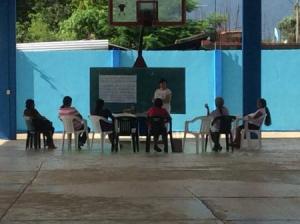Conflict Resolution in Indigenous Communities of Oaxaca, Mexico
Conflict Resolution in Indigenous Communities of Oaxaca, Mexico
 In the summer of 2015, I spent two months practicing conflict analysis and resolution in two communities in Oaxaca, Mexico: Zimatlán de Lázaro Cárdenas and San Sebastián Nopalera. These neighboring communities are part of an “ejido”- a community dotation of land granted by the Mexican Federal Government. Zimatlán has plain and humid lands where several tropical fruits can be grown while Nopalera is located in mountain lands.
In the summer of 2015, I spent two months practicing conflict analysis and resolution in two communities in Oaxaca, Mexico: Zimatlán de Lázaro Cárdenas and San Sebastián Nopalera. These neighboring communities are part of an “ejido”- a community dotation of land granted by the Mexican Federal Government. Zimatlán has plain and humid lands where several tropical fruits can be grown while Nopalera is located in mountain lands.
Zimatlán and Nopalera also had old relationships, even some family ties; however due to the limitation of land in the region, these communities finally had an armed confrontation in 2010. As a result, nine people people died and others were injured on both sides. This resulted in the organization representing Zimatlán, CEDHAPI, and the organization representing Nopalera, Comuna Oaxaca, attempting to resolve the conflict between the parties, at the request of the communities themselves. Eventually, the communities signed an agreement in the Organization of American States (OAS) in Washington D.C., and this is where I first met the representatives of parties to the conflict. The agreement they signed included the division of the “ejido,” but, it was not established with new physical and legal land limits.
Unfortunately, five years after the process of dividing the “ejido,” both parties are still afraid of aggression by the other, and this is why I felt compeled to help them resolve their issues.
I decided to assist these communities by way of designing and facilitating workshops, to try to help them resolve their conflict. My main objective for the two communities was emotional recovery, since according to the reconciliation theories, it is a requisite for long term peaceful relationships. Thus, I started this process by conducted workshops with approximately 30 teenagers, 200 women, and 100 men from Zimatlán and Nopalera. The teenagers’ workshops were dedicated to grasping knowledge from the participants about the conflict and its consequence for them and their communities. After hearing from them about their reservations of the "other," I introduced some "good communication" strategies to them to prevent misconceptions, which could lead to further violent conflict. In the case of the men of the communities, I went directly to the recognition of the causes of the conflict and then we practiced some problem solving exercises. With the women, the starting point was emotional healing. The women manifested their need to reach an agreement with the other community even as they expressed their disappointment on not being part of the initial agreement.
After the workshops, I attempted to analyze and understand the causes of the conflict from the various groups' points of view and then tried to replace their insecurity and fears with their understanding of their conflict, thus creating a sense of control and agency.
In designing these workshops, I used the knowledge and experience I obtained in the Reflective Practice in Interpersonal-Multiparty Conflicts course and the Conflict Analysis and Resolution Advanced Skills course taught at S-CAR. The emotional recovery workshops were taken from the Psychosocial Trauma and Healing course, also taught at S-CAR. I also had to carry out many activities that did not appear in my planning stage but later proved to be fundamental for the success of this project. This was a very important lesson that I learned. Before this internship, I did not understand why people said that most of the time spent for a facilitation or peace building project was dedicated to the planning stage. Now through this experience, I have a better grasp of its importance. In addition, this was a good opportunity to practice in a real setting many of the principles, theories, activities, and techniques I am learning at S-CAR. With regard to personal challenges, the skills that I acquired were those related to self-control. It was also very difficult for me to adapt to a very different context, including the people, food, and staying in small villages. In addition to that, I felt that my personal security was at stake as I was afraid that one group would consider me to be a spy. All of these experiences have me currenty reflecting on whether working with communities is what I want to do in the future. Although part of the answer is yes, circumstances would have to be different. In retrospect, I consider that the work that I tried to implement has to be done by people living in the geographical and cultural context they are working in. Through this, they can be in a better position to dedicate more time to the conflict. In any case, this experience was a turning point for me as elements that I initially discarded such as government involvement, cooperation from representatives, mistrust among people, as well as lack of time and resources all proved to be essential for any lasting peace process.
In conclusion, I learned a lot about the practical applications of conflict analysis and resolution skills to indigenous communities, as well as my own personal abilities and boundaries. I realize that working with indigenous communities could lead to a double challenge since aside from the material conflicts they may be experiencing, elements such as an identity conflict, economic development and modernization and even just keeping one's language, religion and ancient traditions are equally important. My experiences in the field and at S-CAR have helped me put into perspective any future resolution of the conflict between Zimatlán and Nopalera.
### The General Assembly of Zimatlán's ejidatarios. Photo: Demian E. Rosas Galicia




